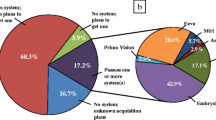Abstract
Purpose
To test whether an electronic whiteboard in the IVF laboratory increases the likelihood that critical evaluation procedures are performed within optimum pre-set time ranges.
Methods
A retrospective cohort study of oocyte retrievals in our IVF clinic between 06/01/2012 and 05/31/2018 was included. The electronic whiteboard was introduced on 04/06/2014. Prior to implementation, embryologists strived to adhere to the set evaluation times without a formal guide. The primary outcomes were the proportion of embryologist evaluations performed in optimum time ranges and the proportion of usable embryos per patient.
Results
A total of 4645 retrievals met inclusion criteria. Implementation of the whiteboard was associated with (1) an increase in the proportion of fertilization checks performed within the optimum time range for ICSI cycles (+ 5.1%, RR = 1.06, CI = 1.02–1.10); (2) an increase in the proportion of day 3 evaluations performed within the optimum time range, whether assisted hatching was performed (+ 23.6%, RR = 1.48, CI = 1.36–1.60) or not (+ 13.8%, RR = 1.23, CI = 1.12–1.35); and (3) an increase in the proportion of day 5 evaluations within the optimum time range (+ 15.5%, RR = 1.23, CI = 1.12–1.35). Additionally, the mean number of usable embryos per patient increased from 2.8 to 4.5 after the whiteboard was implemented (RR = 1.25, CI = 1.19–1.31).
Conclusion
The use of an electronic whiteboard that posts optimum times for performing critical procedures significantly increases the proportion of evaluations that occur within these ranges. Such improved standardization led to positive downstream effects on the number of usable embryos per patient. We suggest that electronic whiteboard implementation driven by real-time data collection should be considered in all IVF laboratories.


Similar content being viewed by others
References
ASRM and SART. Revised guidelines for human embryology and andrology laboratories. Fertil Steril. 2008;90:S45–59.
Olofsson JI, Banker MR, Sjoblom LP. Quality management systems for your in vitro fertilization clinic’s laboratory: why bother? J Hum Reprod Sci. 2013;6:3.
De los Santos MJ, Apter S, Coticchio G, Debrock S, Lundin K, Plancha CE, et al. Revised guidelines for good practice in IVF laboratories (2015). Hum Reprod. Oxford Academic. 2016;31:685–6.
Cutting R, Pritchard J, Clarke H, Martin K. Establishing quality control in the new IVF laboratory. Hum Fertil (Camb). 2004;7:119–25.
Bormann CL, Racowsky C. Quality assurance in the IVF laboratory. In: In vitro fertilization: a comprehensive guide. New York: Springer-Verlag; 2012. p. 225–47.
Alper MM. Experience with ISO quality control in assisted reproductive technology. Fertil Steril. 2013;100:1503–8.
SenGupta S, Dhanjal S, Harper J. Quality control standards in PGD and PGS. Reprod BioMed Online. 2016;32:263–70.
Gjære EA, Lillebo B. Designing privacy-friendly digital whiteboards for mediation of clinical progress. BMC Med Inform Decis Mak. 2014;14:27.
Randell R, Greenhalgh J, Wyatt J, Gardner P, Pearman A, Honey S, et al. Electronic whiteboards: review of the literature. Stud Health Technol Inform. 2015;210:389–93.
France DJ, Levin S, Hemphill R, Chen K, Rickard D, Makowski R, et al. Emergency physicians’ behaviors and workload in the presence of an electronic whiteboard. Int J Med Inform. 2005;74:827–37.
Goyal AA, Tur K, Mann J, Townsend W, Flanders SA, Chopra V. Do bedside visual tools improve patient and caregiver satisfaction? A systematic review of the literature. J Hosp Med. 2017;12:930–6.
Le V, Wagar EA, Phipps RA, Del Guidice RE, Le H, Middleton LP. Improving patient experience of wait times and courtesy through electronic sign-in and notification in the phlebotomy clinic. Arch Pathol Lab Med. 2020;144(6):769–75.
Racowsky C, Combelles CM, Nureddin A, Pan Y, Finn A, Miles L, et al. Day 3 and day 5 morphological predictors of embryo viability. Reprod BioMed Online. 2003;6:323–31.
Alpha Scientists in Reproductive Medicine and ESHRE. The Istanbul consensus workshop on embryo assessment: proceedings of an expert meeting. Hum Reprod. Oxford Academic. 2011;26:1270–83.
Acknowledgments
We would like to thank all members of our embryology team at Brigham and Women’s Hospital for their enduring commitment to provide the highest quality of care to each patient.
Author information
Authors and Affiliations
Corresponding author
Ethics declarations
Conflict of interest
The authors declare that they have no conflict of interest.
IRB approval
This study was approved by the Partners Institutional Review Board at the Brigham and Women’s Hospital (Protocol #2018P002360) with a waiver for informed consent.
Additional information
This study was presented as an oral at the American Society for Reproductive Medicine Annual Conference, October 14th, 2019, in Philadelphia, PA.
Publisher’s note
Springer Nature remains neutral with regard to jurisdictional claims in published maps and institutional affiliations.
Rights and permissions
About this article
Cite this article
Romanski, P.A., Thomas, A.M., Patel, J. et al. Electronic whiteboard implementation as a quality management tool optimizes IVF laboratory standardization and improves clinical outcomes. J Assist Reprod Genet 38, 203–210 (2021). https://doi.org/10.1007/s10815-020-02007-x
Received:
Accepted:
Published:
Issue Date:
DOI: https://doi.org/10.1007/s10815-020-02007-x




